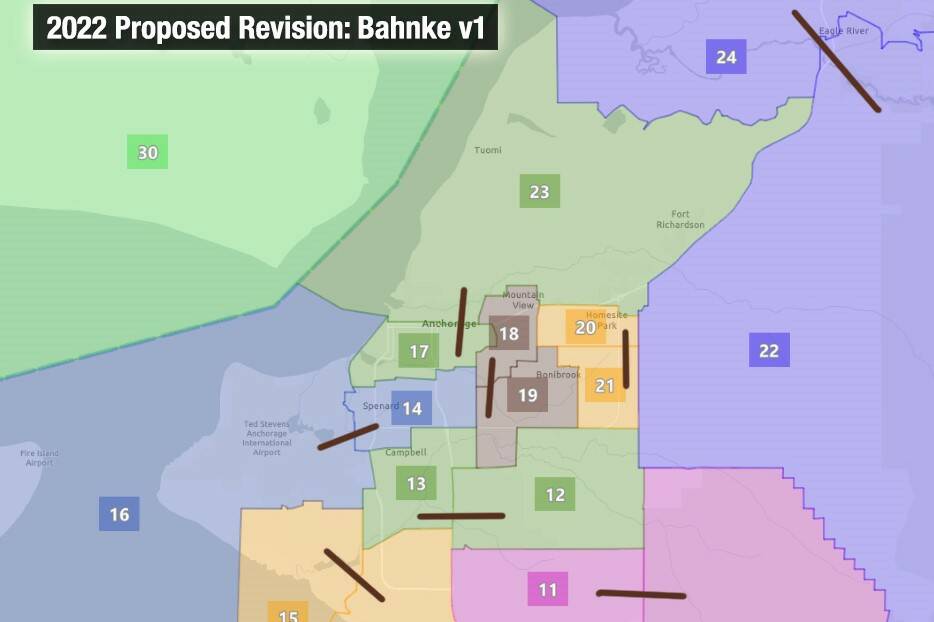The Alaska Redistricting Board on Tuesday scheduled additional public testimony meetings as members work to finalize the state’s new legislative district by April 15.
Several of the board’s proposals for legislative districts were found to be unconstitutional by the Alaska Supreme Court, and members were given an April 15 deadline to present alternative maps. One of the issues cited by the court was the board’s proposal to pair a legislative district for the Alaska House of Representatives in East Anchorage with a district from nearby Eagle River into a single seat in the Alaska State Senate.
Plaintiffs from East Anchorage sued, arguing that comments from board member Bethany Marcum — appointed by Gov. Mike Dunleavy — showed a deliberate effort to boost the influence of Eagle River which currently has only one Senate seat. The board’s initial proposal would have split paired each of Eagle River’s House districts with an adjoining Anchorage district, thereby increasing the number of Senators representing the area. Eagle River is a part of the Municipality of Anchorage, but some in the community — including its current senator, Republican Lora Reinbold — have advocated for the city to exit the municipality.
In February, an Anchorage Superior Court agreed with the East Anchorage plaintiffs and with plaintiffs from the City of Skagway who argued the board had ignored their public testimony. Skagway residents overwhelmingly testified in favor of being placed in the same House district as downtown Juneau, citing similar cruise-ship-based tourism, but were ended up in the same district as the Mendenhall Valley.
In March the Alaska Supreme Court found in favor of the East Anchorage residents but ruled against the residents of Skagway. The board also faced lawsuits from the City of Valdez; the Matanuska-Susitna Borough and Alaska Native regional corporation Calista Corp, but with one exception the courts ruled in favor of the state’s proposals for those areas. The exception is what the court called, “the Cantwell Appendage,” — an area on the border between the Matanuska-Susitna and Denali Boroughs meet, and three House districts converge. The Supreme Court ruled board members had included the city of Cantwell into the proposed House District 36 without sufficient justification.
Board members heard public testimony Monday and Tuesday on potential alternatives as proposed by board members themselves or members of the public. Several proposed plans, including one from board member Melanie Bahnke — appointed by former Chief Justice of the Alaska Supreme Court Joel Bolger — would keep the board’s House districts intact but would create alternative Senate district pairings.
Proposed Senate pairings in Anchorage were also submitted by Anchorage Assembly member and candidate for U.S. Congress Christopher Constant and former Chair of the Alaska Republican Party Randy Ruedrich.
Public testimony at times grew contentious, as several callers accused board members of trying to inject political advantage into Anchorage’s legislative districts.
“There are some people on the board and there are so other so-called, you know, testifiers, that have been on and I just know that they’re politically motivated,” said Eagle River resident Susan Fischetti, in her public testimony. “That this is a gerrymandering move in my opinion.”
Several callers referred to Bahnke’s maps as the ‘Senate Minority’ plan, in reference to text messages Senate Minority Leader Tom Begich, D-Anchorage, sent to board member Nicole Borromeo during the initial planning process in regards to a map he and other senators proposed.
“I worked on this plan with (Board member Bud Simpson) during the work session and it’s a plan that I listened to the advice of our (Voting Rights Act) expert and our attorney,” Bahnke said. “I did not work with Scott Kendall or Tom Begich or even Nicole (Borromeo) on this map.”
The deadline for proposal submission is noon Wednesday but the board has scheduled several days of public testimony. Board members will meet Wednesday from 10 a.m. to noon, and then Thursday through Saturday this week from noon to 2 p.m. Public testimony can be submitted online, by email, or by calling in during a scheduled public hearing.
Meetings to finalize the senate pairings were scheduled for April 13-14.
• Contact reporter Peter Segall at psegall@juneauempire.com. Follow him on Twitter at @SegallJnuEmpire.

